9 things to do and see in Ubud
As mentioned in my previous post, I recently went to a yoga and surf retreat in Bali. The retreat was in Uluwatu, on the south-western tip of the Bukit Peninsula. Home to the Pura Luhur Uluwatu Temple, Uluwatu is nowadays famous for its world class surfing spots. On the other hand, inland Ubud is widely considered the Mecca of yoga. Because of this, I headed there for a few days after the retreat. Today, I’m recommending 9 things to do and see in Ubud.
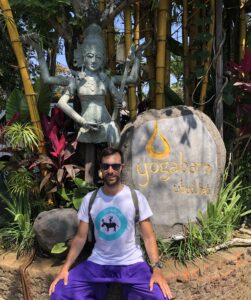
Yoga
Ubud is not short of yoga retreats and yoga centres. The Yoga Barn is probably the most famous yoga centre in Bali. It is within walking distance from the Monkey Forest, one of Ubud’s main tourist attractions. After a morning power yoga class at the Yoga Barn, I had breakfast at their café restaurant. I then set off to explore Ubud.
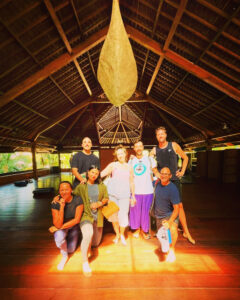
Another option is Alchemy. This is a vegan café-restaurant located close to the Gunung Lebah Temple, another one of Ubud’s main sights. However, as well as a place to eat, drink or work remotely, Alchemy is also a place to do yoga and meditate, an alternative to the Yoga Barn.
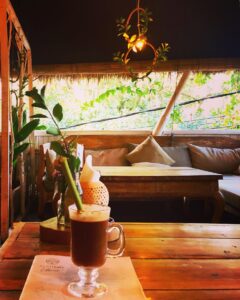
Monkey forest
As well as hundreds of long-tailed monkeys, the Monkey Forest is also home to three Hindu temples, well-worth a visit. Before my visit, I had read that the monkeys could snatch one’s valuables. However, when I visited, the monkeys were well-fed and basically minded their own business. There was a small entrance fee.
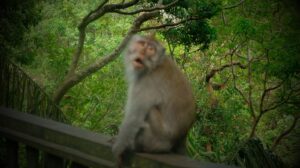
Pura Gunung Lebah
Also well-worth a visit is the Gunung Lebah Temple (Pura Gunung Lebah), within walking distance from Alchemy, but also from the town centre. Built in the 8th century AD, the temple sits on a rock at the confluence of two rivers. From there, I went for a riverside walk (the Campuan Ridge walk), before heading towards the town centre to visit the Taman Saraswati temple.
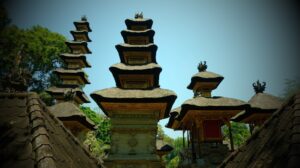
Pura Taman Saraswati
Also known as the Ubud Water Palace, the Taman Saraswati temple (Pura Taman Saraswati) is within walking distance from the Gunung Lebah Temple. It is dedicated to Saraswati, the Hindu goddess of knowledge, music, art, speech, wisdom, and learning. The most notable feature of the temple is its lotus pond and water garden, which mark the outer area of the actual temple. There was a small entrance fee for the lotus pond and water garden, access to the actual temple is not allowed to foreigners.
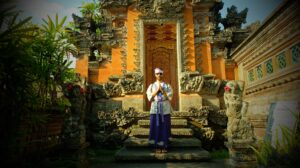
Opposite the temple, there’s Ary’s book café, which opens up to a hidden, tranquil garden. I went there to have a coffee, but I also ordered coconut pancakes. Easily one of my favourite places to eat in Ubud.
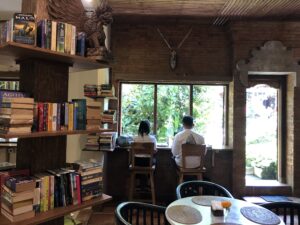
Ubud Palace (Puri Saren Agung)
Afterwards, I continued to the Ubud Palace, which is only a couple of minutes’ walk from the Taman Saraswati Temple. At the time of my visit, there was no entrance fee. However, a ticket is required to watch the Balinese dance performances that take place here in the evenings.
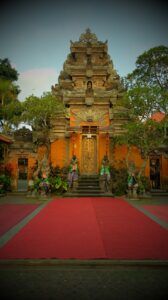
Tegenungan waterfall
There are many waterfalls in Bali. Of those, I visited Tegenungan, on the outskirts of Ubud (10 km south of the town centre). Unfortunately, there were a lot of tourists, some of whom had littered the place. I would highly recommend a drink at Omma Day Club against a spectacular backdrop. On the one hand, there is the Tegenungan waterfall, whereas on the other, a smaller one at the back. When I visited, Omma Day Club was much less crowded than the waterfall. There was a small entrance fee for the waterfall.
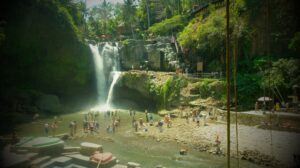
Tegalalang rice terraces
The Tegalalang rice terraces are one of the most characteristic attractions in Bali. They are located about 10 km north of Ubud’s town centre and can therefore be combined with a visit to the Tirta Empul temple. I visited one of those (selected by my driver), where I also had photos taken on a swing, another Bali characteristic attraction.
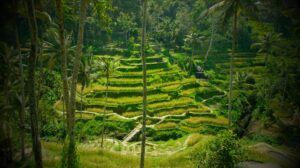
Pura Tirta Empul
Tirta Empul means Holy Spring in Balinese. Pura Tirta Empul is a temple located 15 km north of Ubud town centre. I actually combined my visit there with a visit to the rice terraces. Dating to the 10th century AD, the temple is dedicated to Vishnu, the Hindu god of protection, compassion, tenderness, and love. It is famous for its holy spring water, where the locals go to for ritual purification. Foreigners can also take part in the ritual purification, but cannot enter parts of the temple. I happened to visit after the full moon and was lucky to witness a ceremony taking place at the time of my visit. There was a small entrance fee.
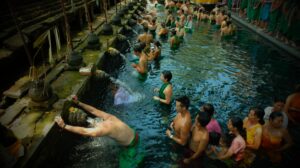
Eat and drink
There are plenty of options in Ubud for eating and drinking. For more information, check out my recently published post ‘10 (+1) places to eat in Ubud, Bali’.

How to long to stay in Ubud
I stayed in Ubud for 4 and a half days (5 nights), which allowed me plenty of time to do yoga, visit the main attractions, eat, drink and do a lot of shopping (there are lots of boutique shops, as well as street markets). I would recommend staying there for at least 3 days to visit the attractions mentioned above.
Where to stay in Ubud
I stayed at the Grand Sehati & Spa. It is a couple of minutes’ walk from the Monkey Forest and within walking distance from many of Ubud’s sights.
Further reading
To better prepare for my trip to Bali, I used the Lonely Planet Pocket Bali.
Health information
To reduce the likelihood of experiencing the notorious ‘Bali belly’, I had the Hepatitis A and Typhoid vaccines 1-2 weeks prior to my departure. A week prior to my departure, I started taking probiotics, which I continued during my stay in Bali. Whilst in Bali, I exercised caution and avoided drinking tap water, eating raw vegetables and buying food from street vendors. As a result, I was fortunate enough not to experience any gastrointestinal symptoms. Moreover, I went to a pharmacy in Ubud, where I bought activated carbon tablets, which can alleviate gastrointestinal discomfort.
Alex
(the Traveling Psychiatrist)
One Comment
Pingback: